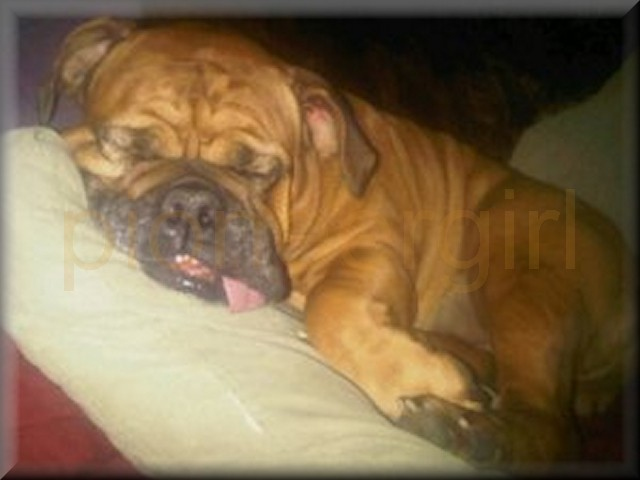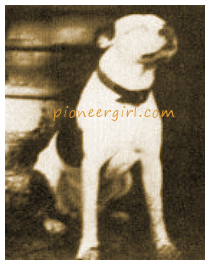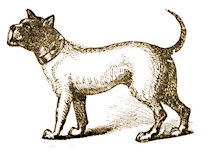bull dog / bulldog

bulldog. A variety of dog, of remarkable ferocity and courage; so named, probably from being employed in baiting bulls, or from the size of the head. — Webster, 1882
brindle. Spotted; variegated with spots of different color. — Webster, 1882
 “If I had a million dollars I would buy a bull dog, a big brindle one. I would keep him under my office desk and if any one came in and said ‘business’ to me I would say, ‘Take him Tige.'” – Mrs. A.J. Wilder, “What Would You Do?” Missouri Ruralist, April 5, 1918.
“If I had a million dollars I would buy a bull dog, a big brindle one. I would keep him under my office desk and if any one came in and said ‘business’ to me I would say, ‘Take him Tige.'” – Mrs. A.J. Wilder, “What Would You Do?” Missouri Ruralist, April 5, 1918.
 Was the Ingallses’ dog, Jack, an English bulldog or an American bulldog or some other breed entirely? Laura never specified, so I don’t see how anyone could know for sure, but I’ve always thought Jack was an English bulldog, probably because Helen Sewell drew him as such.
Was the Ingallses’ dog, Jack, an English bulldog or an American bulldog or some other breed entirely? Laura never specified, so I don’t see how anyone could know for sure, but I’ve always thought Jack was an English bulldog, probably because Helen Sewell drew him as such.
In the years since I first blogged about Jack the bulldog in 2006, I’ve seen the opinion expressed more often than not that Jack was obviously / definitely / emphatically a pit bull. Several times, I emailed the person who made that statement and asked exactly what are they basing that fact on? I’ve also emailed people who wrote that Jack was undoubtedly an American bulldog. I’ve yet to receive a single reply.
I freely admit that I know almost nothing about bulldogs. I don’t care what kind of dog book Jack was (I’m not worried about dogs who played Jack in the television show or movies since I have no problem with hiring the most qualified and best trained dog for the job); I’m simply curious as to why people are convinced Jack was one breed or another, and what are they basing this belief on? Yes, I’ve seen the dog documentary on “Nature.” Yes, I’ve seen old photos showing pit-bull-looking dogs with their owners. I’ve seen old photos showing English bulldogs with their owners, too.
Jack is a main character in only three Little House books: Little House in the Big Woods, Little House on the Prairie, and On the Banks of Plum Creek. He is mentioned in two chapters of By the Shores of Silver Lake (warning: he dies), and he’s remembered once in Little Town on the Prairie.
Of the 80 chapters in the three earlier books, the word bulldog is used in only 5 chapters. The most recognizable phrase is that Wilder refers to him as “Jack, the brindle bulldog.”
Looking at the Helen Sewell and Sewell / Mildred Boyle illustrations only, there are seven illustrations that include Jack: none in Little House in the Big Woods, three in Little House on the Prairie, three in On the Banks of Plum Creek (where Jack is usually drawn as a small part of the action, not its main focus), and one in By the Shores of Silver Lake. Looking at the Garth Williams illustrations only, Jack is pictured one time in Little House in the Big Woods (under the wagon in Chapter 9, “Going to Town,” which is interesting, since Jack isn’t mentioned as actually having gone to town in the chapter). He is pictured thirteen times in Little House on the Prairie, seven times in On the Banks of Plum Creek, and once in By the Shores of Silver Lake, where Williams’ drawing is reminiscent of Sewell / Boyle’s: Laura comforting Jack shortly before Pa is to leave with him for the west (warning: Jack dies).
Whether Helen Sewell and Mrs. Wilder communicated about the drawings is unknown. Sewell clearly drew Jack as an English bulldog, but Jack’s breed was a bit ambiguous as drawn by Garth Williams. He may have drawn Jack with some characteristics of an English bulldog simply because it was how Helen Sewell had drawn him, but most of the Williams illustrations show a much shaggier, hairier dog (English bulldogs don’t grow long winter coats) and/or a dog with a much longer tail than Jack’s supposed “stump of a tail.” I grew up reading the Little House books illustrated by Sewell and Boyle, so their recognizable drawings of Jack as an English bulldog certainly must have caused readers (like me) to believe that Jack was an English bulldog.
Although Wilder used both bull dog (two words) and bulldog (one word) in Pioneer Girl and some book manuscripts, it is always one word in the published Little House books. In the handwritten Pioneer Girl manuscript, Wilder mentions Jack as a bull dog (two words) only once. Both bull dog (two words) and bulldog (one word) are used once in the Big Woods manuscript.
A dogfight story was edited out of the series prior to publication; it appears in both the Prairie and Plum Creek manuscripts (the Plum Creek dogfight story was published in Cobblestone magazine in February 1986). In both stories, Jack gets in a fight with another dog who is brought to the Ingalls home with its owner. In Little House on the Prairie, the dog comes with Mrs. Scott; in On the Banks of Plum Creek, it’s Mrs. Nelson’s dog. Both times, “the other dog was a bulldog too.” I can’t imagine that fighting with another dog of the same breed is bulldog-only behavior.
Again, what are the written clues that suggest that Jack was a pit bull, an American bulldog, or an English bulldog, for that matter? Jack is a guard dog. He has short brown fur. His hackles raise on occasion. His ears perk up and he’s alert even when resting. He sniffs in the wind. He is strong and sturdy when Laura leans against him. Wilder does write that his “teeth showed a bit, but that was because he was a bulldog.” (Do pit bulls’ teeth show regularly?) She mentions Jack’s broad back. In Pioneer Girl, Pa is said to have put Laura “on Jack’s back to ride.”
Wilder also wrote in Pioneer Girl that Jack was left with the horses when they were traded leaving Indian Territory, meaning he wasn’t with the family in Walnut Grove at all. Stories that include a dog after Little House in the Big Woods may have been inspired by Laura’s memories of some dog the Ingallses had later that Laura didn’t name.
Laura and Almanzo Wilder did own one documented bulldog that appears to have been an American bulldog. The photo above shows their dog, Ben. The photo was taken circa 1930, and there are surviving photos of Ben taken through the late 1940s. In the past when Jack has been discussed in internet forums, dog owners have speculated that since the Wilders had this breed bulldog, Jack must have been the same breed that Ben was. I can’t believe that the photo is common enough for the “not Wilder people but dog people” to assume that since this dog (meaning Ben) was a bulldog, Jack was like this dog (meaning the same breed of bulldog). We know that Wilder called this dog a bulldog, since she wrote about him in one of her Missouri Ruralist articles. You can see another photo of Ben with Carrie Ingalls Swanzey and the Wilder’s burro, Jack, in the digital collection of Detroit Public Library HERE.
Until I see some evidence saying otherwise, Jack Ingalls will always be an English bulldog to me. Your mileage may vary. When the set of not-illustrated Little House trade paperbacks first came out, I wonder how new readers pictured Jack while reading…

Jack chained, from Little House on the Prairie, as drawn by Helen Sewell (left) and Garth Williams (right), and the last illustration of Jack as an old dog from By the Shores of Silver Lake, by Garth Williams (center).
Brindled. The brindle coloring of animals (including dogs, cats, cattle, and guinea pigs) means the often distinctive stripes of color (usually black) that overlay a lighter base coat color (white, red, yellow, or cream). The pattern is often referred to as “tiger striped,” but the variation is usually more subtle. It’s a relatively rare coat pattern in dogs; if you’re interested in the science, there are plenty of books and websites to consult about brindle genetics. In the Little House books, Wilder writes about both dogs and cattle that are brindled.
When I think about Jack, I do think of the phrase “tawny-colored and brindled.” Don’t you? Surely Wilder must have described Jack in this way in the Little House books more times that she described him as merely brown. So I went looking.
In Little House in the Big Woods, Jack is described as a brindle bulldog, twice. In Little House on the Prairie, Jack is described as a brindle bulldog (once) and with a brindled head (once). The “tawny animal and brindled’ describes the animal who creeps near the campfire and turns out to be Jack (see Chapter 3, “Camp on the High Prairie”). In both On the Banks of Plum Creek and By the Shores of Silver Lake, Wilder uses both the words tawny and brindled, but not to describe Jack.
So there you have it. Jack was a brown brindle bulldog.

Bulldog illustration from the 1882 Webster’s dictionary.

brindled
dog (BW 1-2; LHP 1, 3, 11; PG)
cattle (BPC 10)
bull dog / bulldog (BW 1-2; LHP 1, 7; BPC 20; SSL 2; LTP 11; PG)
Jack Jack (BW 1-5; LHP 1-4, 6-7, 11, 13-15, 17-19, 21-26; BPC 1-2, 5, 7, 10-11, 17, 20-30, 33-39, 41; SSL 1-2; LTP 11, 15)

